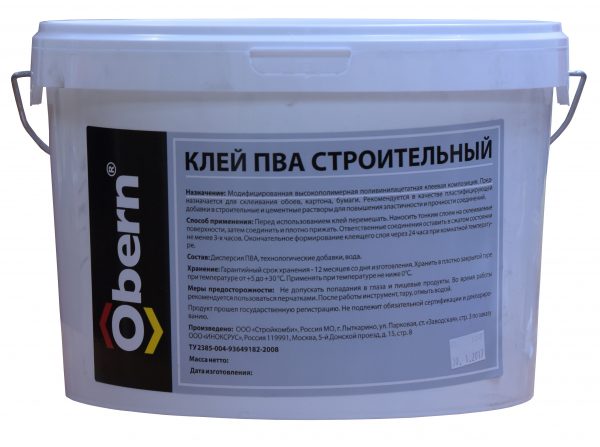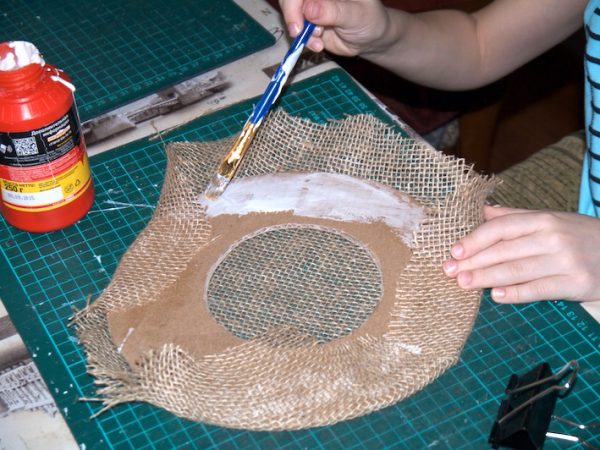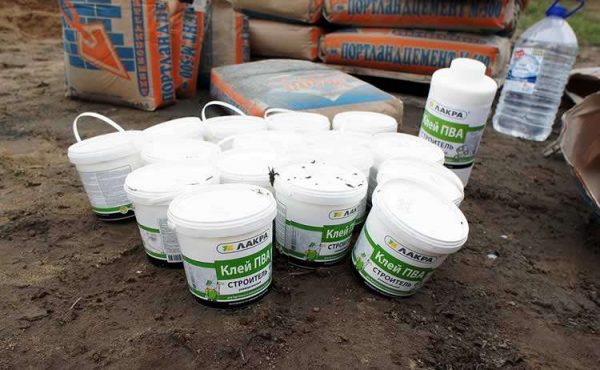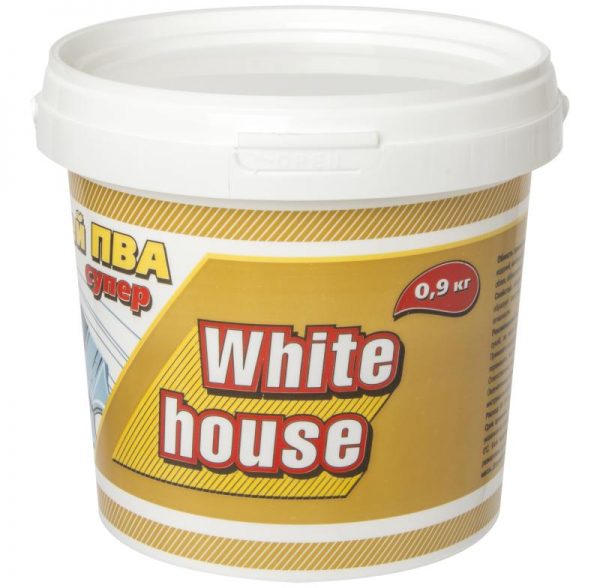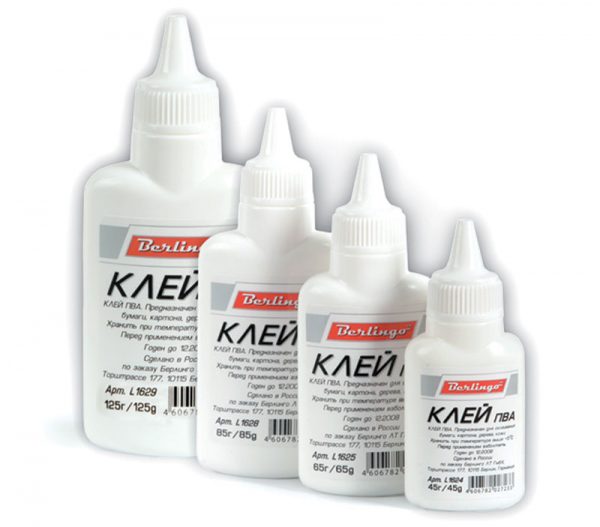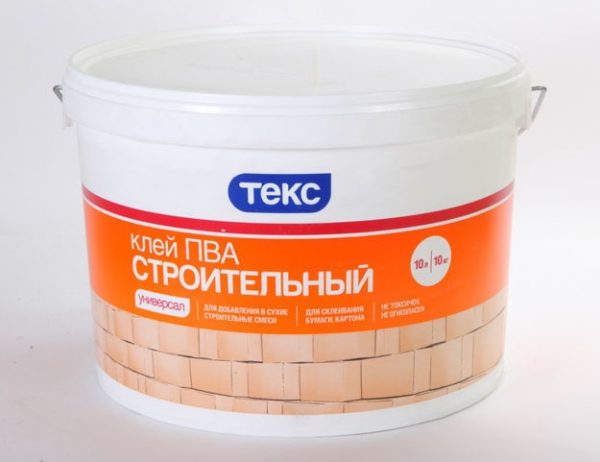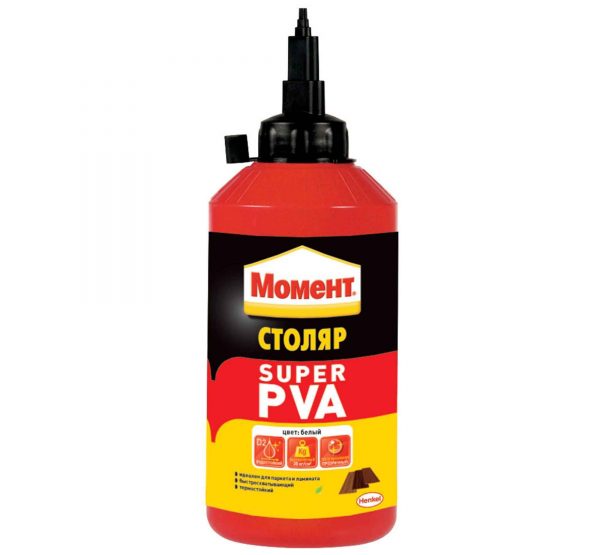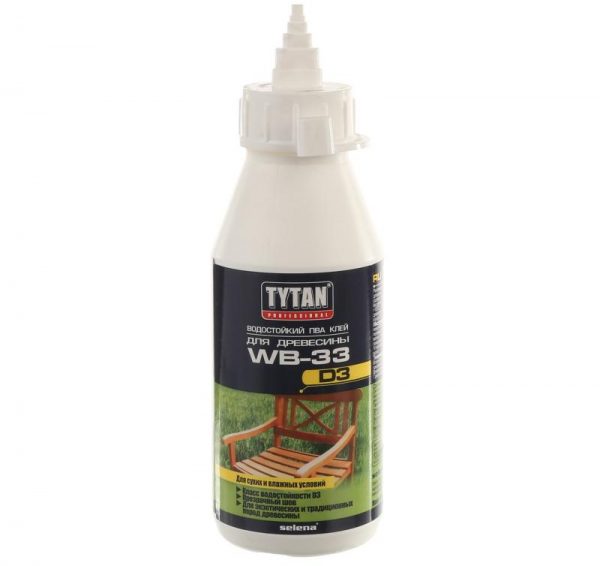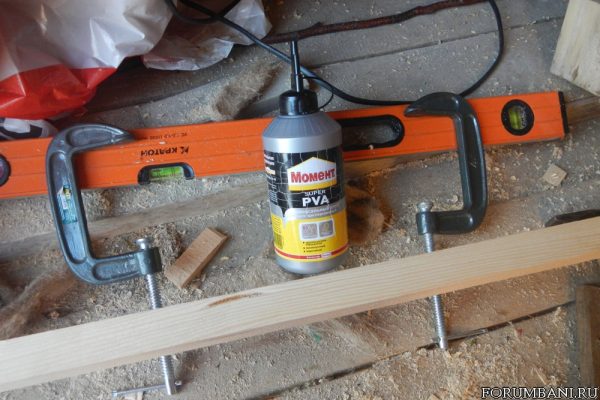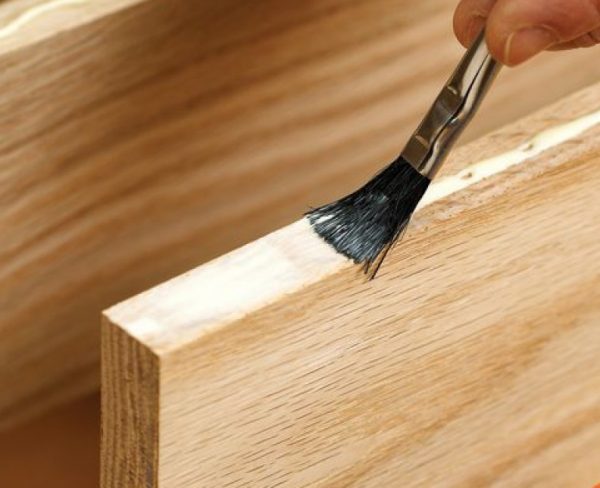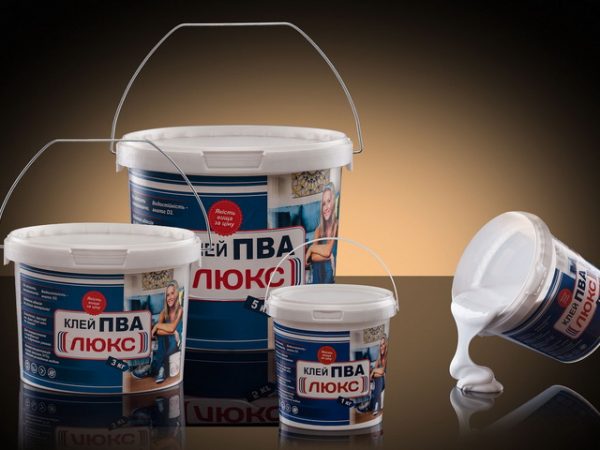PVA glue was invented back in 1912 in Germany, quickly came into everyday life and is now used in a wide variety of fields. The popularity of the product is due to its versatility and the absence of harm to health, especially since the chemical composition of the adhesive is constantly being improved, and this gives it new properties.
- PVA glue: decoding and composition
- Advantages and disadvantages
- Area of use
- Varieties and characteristics of PVA
- PVA household glue
- PVA stationery glue
- PVA universal glue
- PVA Superglue
- PVA construction glue
- Factors Affecting Drying Time
- Reasons and rules for dilution
- Adhesive Tips
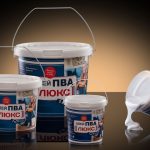
PVA glue: decoding and composition
PVA glue is a chemical product with excellent adhesive properties. The abbreviation is simple: the letters indicate the active substance - polyvinyl acetate, its composition is about 95%. The remaining glue formula looks different depending on the specific type of product. The composition may include:
- DOS (stands for dioctyl sebacinate);
- dibutyl phthalate;
- other plasticizers;
- tricresyl phosphate;
- acetone;
- esters;
- stabilizing additives;
- preservatives;
- water.
Some try to make PVA with their own hands, using recipes based on flour, starch. In fact, these substances have nothing to do with the real glue base. Polyvinyl acetate is produced by polymerizing a vinyl acetate monomer. The finished substance can not be dissolved in water - it only swells, behaves similarly in oil solutions. PVA is resistant to temperature extremes, inert to the action of the air, non-toxic, not harmful to humans.
According to GOST, an adhesive based on polyvinyl acetate must meet the following requirements:
- the absence of a pronounced or unpleasant odor (this indicates a fake or expired glue);
- look - a homogeneous milky-white mixture, sometimes beige or slightly yellowish;
- the adhesive joint becomes a viscous translucent film after drying;
- the strength and elasticity of the seam are at a high level.
Depending on the user's needs, the properties of the adhesive can be changed by adding other substances to its formula. For example, some construction PVA not only consist of polyvinyl acetate and plasticizers - kaolin, talc, and chalk help to thicken the solution. To increase water resistance, gasoline is introduced into the composition, to increase the elasticity of PVA is done with the addition of oils, glycerin, but this reduces the strength characteristics. Other possible additives to the glue composition:
- defoamers;
- cellulose;
- metal crumb;
- glass chips;
- nitro compounds;
- styrene;
- polysilicates of sodium, lithium, potassium.
to contents ↑Manufacturers of solid PVA adhesives in the form of pencils have to replace polyvinyl acetate with PVP (can be decoded as polyvinylpyrrolidone) or combine two components. The specified substance is more dense, characterized by high adhesive abilities.
Advantages and disadvantages
The glue is very convenient to use, easy to apply, does not spread. When it is thick, you can dilute it with water, however, this is not about all varieties of PVA. How long does the product dry? Drying time depends on the ambient temperature, application area and is 12-24 hours, which is a low indicator for adhesives.
Other advantages of the composition:
- does not include substances harmful to the body, is approved for use by children from 3 years old;
- safe in contact with skin, you can use the product even without gloves;
- not flammable, explosive;
- resistant to mechanical stress;
- plastic, elastic, so the adhesive seam does not deteriorate under dynamic loads;
- withstands several cycles of freezing and thawing;
- can be used even indoors due to the absence of an unpleasant odor and harmful fumes;
- has a low consumption - 100-500 g / sq. m;
- possesses excellent adhesive abilities - up to 550 N / m;
- not destroyed by ultraviolet radiation;
- perfectly fills all cracks, cracks, gaps, pits;
- sold in a variety of packaging volumes;
- can be used independently or as a basis for primers, putties;
- dried glue does not shrink, does not deform the glued product.
It is easy to wipe the glue stain from different surfaces. Despite its solubility only in chemicals, PVA is washed off with plain water. The tool also has disadvantages. The glue is not stored for too long - up to 6-12 months, after this time it is able to permanently deteriorate. In the presence of additional chemical components, the degree of safety can change, and you will have to work with glue using personal protective equipment.
to contents ↑Area of use
The most widely used tool in children's creativity. PVA is very popular in schools, kindergartens, clubs, and developing studios. To work with him, the child will not need special clothes. Stains can be removed in a conventional washing machine. Glue will easily fasten paper, cardboard, threads, fabric, etc. When mixed with gouache, glue is painted on canvas, because such paint will be resistant, will not fade.
to contents ↑PVA is used in construction works: from wallpapering to installing parquet, laminate, tiles. The glue is suitable for impregnating wood in order to give it water-repellent properties. When 5-10% PVA is added to a regular cement mortar, the latter's ability to waterproofing is seriously increased, as well as ductility, adhesion to the base. 70 g of PVA per 10 l of the bulk are added to the plaster. This helps to quickly dry the coating, and also allows the mortar to lie better on the wall.
Varieties and characteristics of PVA
There are several types of PVA glue, and its technical characteristics, scope depend on the specific form. The tool is popular in everyday life and construction, among schoolchildren and hostesses, it is only important to choose it correctly for each individual case.
PVA household glue
Usually it is recommended to use it instead of wallpaper glue for gluing heavy canvases - vinyl on a non-woven basis, fiberglass, photo wallpaper, fabric. It gives a good degree of adhesion to surfaces such as concrete, drywall, brick with plaster.
Household glue is great for working with cardboard, paper, foam rubber, textiles, decoupage with PVA is possible. Its consistency is moderately thick; it looks like a milky white liquid, sometimes with a yellow tint. The glue is frost-resistant, can withstand freezing up to -40 degrees and retains its properties after defrosting. When the expiration date of household PVA can go lumps floating in a clear liquid.Most often, glue is produced in large cans, buckets.
The most popular brands of this type of PVA:
- Big (Big);
- Attomex (Atomex);
- "Profilux";
- White House.
PVA stationery glue
This type of glue (PVA-K) is similar to the previous one. Office PVA is also used for domestic needs, usually for crafts, children's creativity. It is available in liquid form in bottles, small jars (50-250 g), as well as in the form of a dry adhesive pencil. To make the pencil slide on paper, manufacturers introduce a little glycerin into its composition.
The choice of such tools is the largest. The most famous adhesives of such companies:
- "Tape";
- Erich Krause (Erich Cruiser);
- "365 days";
- "Ray";
- Office Space (Office Space);
- Attache
- Adel;
- Bic White Glue;
- Dolce Gusto (Dolce Gusto);
- "Centrum";
- Deli (Delhi);
- Berlingo.
One of the highest quality adhesives in this group is considered to be the American Elmers (Elmers). It is this colored PVA used for the manufacture of toys "lizunov" mixed with sodium tetraborate. It is not difficult to make lizuns at home - you just need to combine PVA and sodium tetraborate in equal amounts. In order not to purchase a fake, when buying Elmers glue, you need to request a certificate of conformity, specify the HS code.
to contents ↑PVA universal glue
Universal adhesive is marked with MB marking. It can stick different types of materials, it is used to fasten cardboard products, wood, glass, leather. It is possible to glue linoleum, sickle, carpet, glue the product with a pavement. The tool is often introduced into the composition of building mixtures on a water-dispersion basis. The glue is moderately frost-resistant, withstands temperatures up to -20 degrees.
On sale, you can also find a modification of PVA-MB, which is called PVA-M. It differs from the previous version in low price, but the quality is also reduced. This tool is not recommended to work on materials other than cardboard, fabric, paper. The best brands of adhesives for universal use:
- "Lacra Extra";
- Tex Universal;
- "Comus";
- Schreiber;
- "Navigator";
- "Omega";
- PVA-801;
- Brauberg.
PVA Superglue
The composition of this product contains special additives that, after drying, make the adhesive joint very durable. Super-PVA can be used not only for wallpapering and household needs, but also for repairing tiles in the bathroom, in the kitchen. It will help restore damaged areas, glue the fallen off elements, replace cement mortar when facing small-sized floor coverings. The composition is moisture resistant (D3-D4), withstands freezing up to -40 degrees, therefore it can be used in unheated rooms, for outdoor use. Popular brands:
- AHT;
- Akron
- Novohim;
- “Moment Carpenter Super-PVA”;
- White House.
PVA construction glue
Household adhesives are unstable to moisture, it is not recommended to use them where the humidity indicator is increased. Therefore, professionals prefer to use PVA construction glue - a waterproof composition (D3 or D4) in the form of an emulsion, which contains special polymerizing particles. Due to the special composition, the level of adhesion with the base increases. Dispersion of PVA is also introduced into the composition of various building mixtures, primers, paints as a thickener and plasticizer. Further, such mixtures are used when laying bricks, installing tiles, pouring screed.
A type of building is considered to be carpentry glue - it is used on wood, veneer, chipboard, fiberboard and other derivatives of wood, chip materials. Joiner glue is often called furniture glue - it is widely used in the manufacture of furniture and components.
The moisture resistance of such products is marked with the letter D and a number from 1 to 4. The color is usually transparent, the viscosity is increased. Frost resistance is also high (up to -40 degrees), adhesives are suitable for outdoor use. The advantages of building PVA are also low consumption per 1 m2, resistance to UV radiation, high strength, lack of shrinkage, quick drying.
Popular manufacturers in Russia and abroad, which produce PVA of this group, are as follows:
- "Titanium";
- "Contact";
- Lacra Lux;
- Tex
- "Moment".
Factors Affecting Drying Time
Sometimes it is necessary to speed up the drying time of PVA, because at a cool temperature in the apartment it can be about a day. This also happens with a large glue application area, a too thick seam (under standard conditions, two pieces of paper glued together will dry out within 15 minutes). To start using the product faster, you must follow these instructions:
- Prepare the base in advance with high quality - remove dust, debris, degrease with acetone (degreasing will also help to cover the product with a uniform adhesive layer);
- to apply glue, use a roller, not a brush - so the layer will turn out thinner;
- ensure tight compression of surfaces, for example, put glued objects under the press, clamp with a vice;
- Moderately increase the temperature - you need a construction or regular household hair dryer or putting the item in the microwave for a few seconds.
When heating, it is important not to overdo it: if the temperature of the adhesive joint is more than + 100 ... + 120 degrees, the PVA will begin to break down.
to contents ↑Reasons and rules for dilution
What is the best method to apply if the glue has thickened? The easiest way is to dilute it with water, adding it literally in grams, so as not to make the composition too liquid. Water will not worsen the properties of stationery and household adhesives. All other types of PVA, especially construction, are strictly forbidden to breed with water, they will lose their adhesive function. How to dilute such a composition is indicated on the package, usually acetone is suitable for this.
If you make the composition more liquid, its consumption will decrease. You can also dilute PVA to obtain a primer. Most often, add 1 part glue to 5 parts water to get a high-quality primer for walls and ceilings. Sometimes it happens that glue, on the contrary, needs to be made thickened to enhance its adhesion to the surface or to prevent deformation of thin materials. The composition is easily translated into a more dense state: you just need to leave the jar open for a day, and excess moisture will evaporate.
to contents ↑
Adhesive Tips
To get a really high-quality connection of parts, the following recommendations should be observed:
- mix glue well before use;
- work with the composition at a temperature of +10 degrees, humidity up to 80%;
- always apply the product on clean substrates;
- provide surface dryness;
- lubricate one part with glue, an excessively thick layer will only reduce the adhesion of the composition;
- observe the thickness of the adhesive film up to 2 mm;
- Do not touch the product until completely dry.
Despite the low cost, PVA has excellent operational characteristics, so it does not lose popularity in everyday life, at a construction site. The environmental friendliness and effectiveness of the product allows it to be on the leaderboard, which also contributes to the availability of glue for any user.

